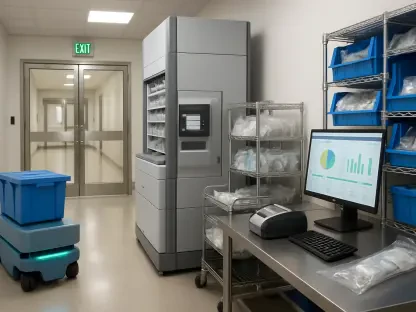In an era where chronic diseases like diabetes, obesity, and autoimmune disorders burden millions globally, pharmaceutical giant Eli Lilly is spearheading a transformative approach by integrating digital health solutions into its core operations. This strategic shift goes beyond merely adapting to industry trends; it represents a proactive effort to dismantle the inefficiencies of traditional specialty pharmacy systems that often result in poor patient adherence and fragmented care. By harnessing cutting-edge technology and forging impactful partnerships, Lilly is not only aiming to improve health outcomes for patients with complex conditions but also positioning itself for sustainable, high-margin growth in a fiercely competitive healthcare sector. This bold pivot underscores a broader vision to redefine how chronic disease management is approached, promising a future where technology and medicine work hand in hand to deliver seamless, patient-centered care that addresses long-standing challenges with precision and innovation.
Transforming Patient Care with Digital Innovation
Eli Lilly’s commitment to revolutionizing chronic disease management shines through its adoption of digital tools designed to streamline the often cumbersome processes associated with specialty medications. A prime example lies in its collaboration with Senderra Specialty Pharmacy through the SenderraCare+ platform, which reimagines critical steps like patient enrollment and prior authorization. These medications, vital for treating complex conditions such as diabetes and autoimmune diseases, frequently face delays and abandonment due to systemic inefficiencies. By offering real-time support and adherence tracking, this platform has managed to reduce treatment abandonment by up to 40%, ensuring patients start and stick with their therapies more effectively. This digital intervention not only eases administrative burdens but also fosters a more connected and responsive care experience, setting a new standard for how complex treatments are managed in the healthcare ecosystem.
Expanding beyond specific platforms, Lilly’s broader digital health strategy encompasses initiatives like LillyDirect, which brings telehealth capabilities into new therapeutic areas such as Alzheimer’s care. The integration of artificial intelligence (AI) and remote monitoring technologies further enhances the management of chronic conditions by providing personalized insights and timely interventions. For patients grappling with lifelong health challenges, this means a more cohesive journey where adherence is supported by data-driven solutions that adapt to their needs. The ripple effect is significant—improved health outcomes drive greater demand for both Lilly’s pharmaceutical offerings and its complementary digital tools. This synergy creates a self-reinforcing cycle that benefits patients by prioritizing their well-being while simultaneously strengthening Lilly’s foothold in an evolving market focused on patient-centric innovation.
Financial Impact and Market Opportunities
The financial implications of Eli Lilly’s digital health strategy are striking, reflecting a dual benefit of enhanced patient care and robust economic returns. By transitioning from labor-intensive manual processes to efficient digital solutions, the company has achieved remarkable gross margins, reaching 84.3% in the second quarter of this year. This efficiency is amplified by the performance of blockbuster drugs like Zepbound and Mounjaro, which together generated $8.58 billion in revenue during the same period. Pairing these high-performing medications with digital tools ensures patient engagement and retention, establishing recurring revenue streams with significantly lower overhead costs. This model not only bolsters profitability but also creates a sticky ecosystem where patients and providers remain invested in Lilly’s offerings, highlighting a forward-thinking approach to blending healthcare with technology.
Looking ahead, Lilly is strategically positioned to capitalize on the burgeoning chronic disease management market, projected to grow at an annual rate of 7.6% through 2029. Factors such as aging populations and the increasing prevalence of health challenges like obesity and diabetes fuel this expansion, presenting a substantial opportunity for market share capture. Through partnerships like the one with Welldoc, which focuses on AI-driven platforms for cardiometabolic conditions, Lilly is scaling its digital solutions to meet diverse needs across therapeutic areas. This adaptability ensures that the company remains at the forefront of industry trends, ready to address the growing demand for integrated care models. By aligning its innovations with market dynamics, Lilly is not just participating in the healthcare evolution but actively shaping it, reinforcing its role as a leader in delivering value to both patients and stakeholders.
Balancing Innovation with Potential Challenges
While Eli Lilly’s digital health initiatives paint a promising picture, navigating the associated risks remains a critical aspect of sustaining this momentum. Regulatory scrutiny surrounding digital health tools poses a notable challenge, as evolving standards could impose constraints on deployment and scalability. Additionally, pricing pressures within the U.S. market continue to loom large, potentially impacting the affordability and accessibility of both medications and digital solutions. These hurdles underscore the complexity of integrating technology into healthcare, where innovation must be balanced against compliance and economic realities. Despite these obstacles, Lilly’s proactive stance and early adoption of data-driven care models provide a buffer, allowing the company to address potential setbacks with agility and informed decision-making in a landscape that demands constant adaptation.
Countering these risks, Lilly’s financial strength and strategic investments offer a solid foundation to maintain its innovative edge. A $3 billion commitment to expanding manufacturing capacity and a $15 billion share repurchase program signal confidence in the long-term viability of its digital health pivot. This financial muscle, coupled with a first-mover advantage in embedding AI and real-time data into chronic disease care, positions Lilly to outpace competitors who may struggle to match this integrated approach. The ability to leverage technology not only enhances patient outcomes but also fortifies operational resilience, ensuring that challenges like regulatory shifts or market pressures are met with robust solutions. As Lilly continues to pioneer this intersection of pharmaceuticals and digital innovation, it sets a benchmark for how healthcare companies can lead with vision while navigating the intricacies of a rapidly changing industry.
Pioneering a Future in Healthcare Delivery
Reflecting on Eli Lilly’s journey, the strides made in integrating digital health into chronic disease care mark a pivotal shift in addressing systemic inefficiencies that once hindered patient outcomes. The deployment of platforms that streamlined specialty pharmacy processes and reduced treatment abandonment showcased a commitment to tangible impact over mere technological adoption. Financial achievements, mirrored by impressive margins and revenue from key drugs, validated the profitability of this model, while strategic partnerships amplified its reach across diverse health challenges. Despite navigating regulatory and pricing headwinds, Lilly’s foresight in blending AI with patient care established a legacy of leadership. Moving forward, the focus should center on expanding these digital frameworks to underserved areas, ensuring broader access while refining tools to preempt future obstacles. By sustaining this momentum, the path is paved for a healthcare future where technology and compassion converge to redefine wellness on a global scale.









